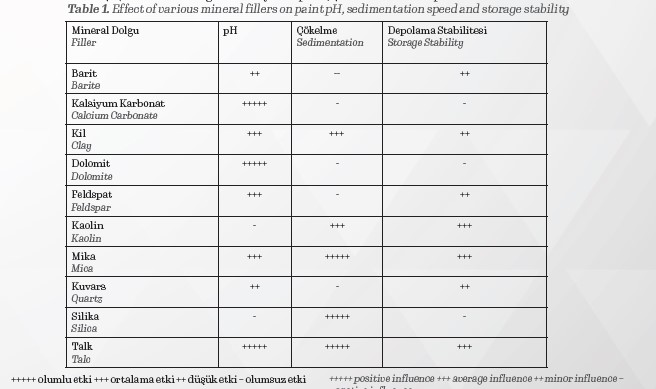Mineral Filler Selection for Paint
Mineral fillers are practically used according to DIN 55943 standards to increase the volume and insoluble in the environment where it is applied, to obtain or increase certain technical features and/or it is defined as owdered substances used to change optical properties.
Fillers are essentially natural minerals. Mineral fillers are solid particles used in paint system to:
1. Improve properties,
2. Lower costs.
Fillers have a significant role in the key properties of paints. Their influence is important during production, storage and application. Here are the main factors which are influenced by filler:
1. pH,
2. Speed of sedimentation,
3. Stability,
4. Wear of equipment,
5. Viscosity.
1.pH
As it is known, pH is a unit of measurement for grading the acidity or alkalinity of a solution. pH of water-based paints is important, for example with respect to colloidal
stability.
Knowing the pH value is very important for paint manufacturers, especially in predicting its
behaviour in the formulation.
Some fillers can influence pH strongly while others have only a minor influence on pH. The surface composition, as well as chemical stability of the filler particles, determines the influence of the particles on pH.
2. Sedimentation Speed
The speed of sedimentation in paints is mainly related
by the:
1. Viscosity,
2. Density,
3. Particle size of the solid particles.
Big particles of high density will sink faster than small particles of low density. When considering the particle size of the primary particles of fillers, most often the median particle diameter of primary particles is given, called d50. Particle size can be given in micrometers (μm) or nanometers (nm).
3. Storage Stability
Different types of stability of solid particles in liquid systems are important:
1. Sedimentation/settling,
2. Dissolution,
3. Chemical stability,
4. Flocculation –This negative process can take place during production, storage, application and film formation.
Flocculation can be prevented by arranging repulsive forces between the particles by adsorbing specific additives, called dispersants, onto the surface of the solid particles.
Whether or not dispersant will be able to adsorb onto the surface of filler particles is determined by the:
1. Chemical composition and morphology of the dispersant molecules, and
2. Surface composition of the solid particles
Most fillers are hydrophilic, implying that polar groups are present on the surface of the particles.
An exception is talc, being a filler having a relatively hydrophobic surface. Hydrophilic particles are easily stabilized because dispersant molecules can adsorb strongly onto
the polar groups being present on the surface of hydrophilic particles.
Dissolution, as well as possible chemical reactions of filler, mainly take place during storage and it depends upon the chemical composition of the filler. It is important to select fillers having chemical resistance against the liquid medium.
Some fillers are not inert, implying that the solid particles can, for example, be attacked by
certain chemicals, solvents, acid, alkali or ultra-violet radiation.
Calcium carbonate (CaCO3), for example, is a filler dissolving slowly in an acidic environment. This implies that one should be careful when using calcium carbonate in water-based systems having low pH, or when the system will be applied on an acidic substrate.

4. Wear of Equipment
Equipment may be damaged both during production and during the application of paint. Fillers having both high hardness and sharp edges (shape) can damage equipment because of wear.
The hardness of a filler indicates how easy or how difficult it is to mechanically damage
the solid. For pigments and fillers the Mohs hardness scale is used to quantify hardness.
The hardest mineral, being diamond, has Mohs hardness being 10, whereas talc, being a soft filler, has Mohs hardness of 1. Hard fillers like quartz, can give wear to production equipment, especially when the particles have sharp edges.
5. Viscosity
Viscosity is the resistance of liquids to flow, that is, to fluidity. Flowability is the absence of resistance of liquids to flow. Viscosity of liquid systems is influenced by fillers, depending on:
1. Particle size ,
2. Particle shape and
3. Surface composition of the filler particles.
Particles with irregular shapes will raise the viscosity of a system. Small or porous particles that adsorb high amounts of resin material result in high viscosity.

Result
Properties of mineral fillers (pH, sedimentation rate, stability, viscosity, etc.) affect paint applications positively or negatively, so choosing the right mineral becomes important.
Prof. Dr. Öner Yusuf Toraman
Mining Engineering Department
Nigde Ömer Halisdemir University
References
Jochum Beetsma, https://coatings.specialchem.com/selection-guide/fillers-selection-for-paints-coatings (28.09.2022)
Ö.Y.Toraman, Boyada Kullanılan Mineral Dolgu Maddeleri, BoyaTürk, Haziran/Temmuz 2016, s.2-4.
Ö.Y.Toraman, Boya ve Plastikte Kullanılan Mineral Dolgu Maddeler, BoyaTürk, Nisan/Mayıs 2014, s.34-36.




